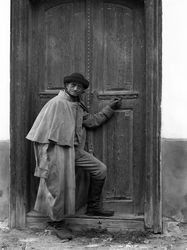Dana Lacková
Pavol Socháň (1862 – 1941) was an influential Slovak ethnographer, painter, illustrator, educator, journalist, playwright, editor, radio drama worker and photographer. He studied at the Academy of Fine Arts in Prague and attended lectures in history of art and ethnography. At that period of his life, he became sure that ethnography is what he is destined for. In 1887, he organised the Slovak embroidery exhibition in Martin which became a breaking event for the history of Slovak ethnography. The period between 1893 and 1912 when he lived in the town of Martin is believed to be the top period in the life of Pavol Socháň as a photographer and ethnographer. He published the oldest book of Slovak embroidery patterns at that time. Socháň wrote 1000+ ethnography-related articles and essays (half of which remained unpublished). His activity as an author is incomparable to any of his contemporaries. He was one of the founders of stock company Lipa/Lime tree in 1910 that traded in folk products, particularly embroideries, lace, fabrics and decorations. Persecuted by the Hungarian state administration, Socháň moved out of Martin to live with his family in Prague where he worked as an editor and journalist. When a warrant was issued to arrest him soon after the First World War had been declared, he emigrated to the U.S.A. Socháň popularised the Slovak folk art, organised exhibitions and lectures while in the U.S. After his return to the newly established Czechoslovakia in 1919, he had a job in the municipal office in Bratislava, worked as an editor in various dailies and in radio.
He decided for photography as a student in Prague. His photo collections of folk costumes serve as the evidence of ethnographic and artistic value of our traditional clothes. Rural people as creators and carriers of folk culture values served as lifelong inspiration for his creative endeavours. Socháň compiled the photographic summary of life of rural people. He recorded the social position of farmers, shepherds, forest workers and small home makers. He created a true picture of their life, clothing, habits and ceremonial events. His work as a photographer was published in a form of picture postcards. They were published in several editions between 1891 and 1924. However, the total number of postcards remains unknown (around 400). His pioneering work has helped to improve photography and inspired other renowned artists such as Karol Plicka and Eugen Lazišťan.
